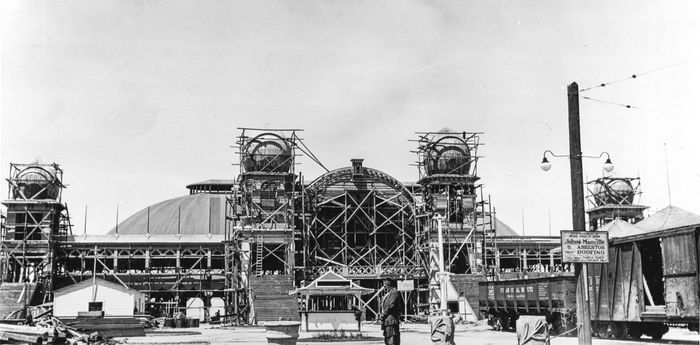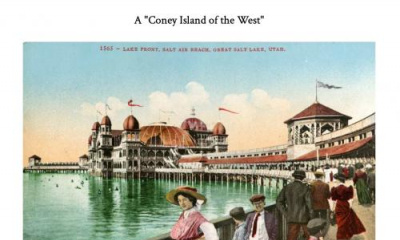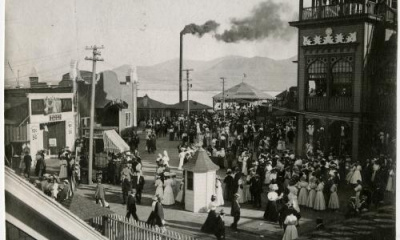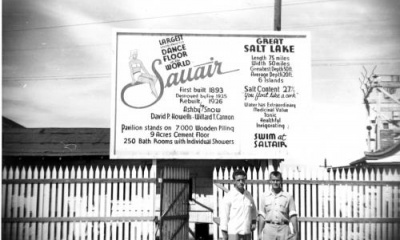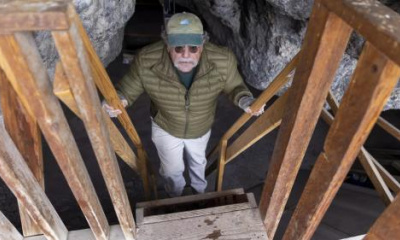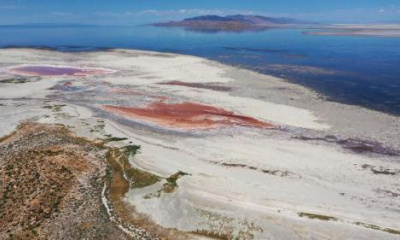The site of the old Saltair resort — actually, three of them — can give a visitor the feeling that something is haunting them.
The historical sites are somewhat reminiscent of a ghost town, and the evidence grows the farther out one journeys.
Remnants of the old Saltair Railway, which a century ago brought people from Salt Lake City to the lakeside resort. What’s left of old wooden posts that once held up an expansive wooden deck. Piles of black clumps in the distance where the “world’s largest wooden roller coaster” once thrilled riders.
They are pieces of a resort, a lifetime, gone and mostly forgotten.
Today, the land is barren and dry, home to scraggly bushes. Occasionally, a bird will fly overhead — the only real sign of life, aside from the distant sound of freeway traffic. A rare breeze might flutter by, carrying the smell from the nearby terminal Great Salt Lake, whose waters once extended out to the resort’s buildings.
When people walk around the old Saltair, they are 12 feet below where the deck and the main pavilion used to be, where salty water lapped against the wooden deck posts.
The location is an archeologist’s gold mine, to which Chris Merritt will attest. Merritt, an archaeologist and Utah’s state historic preservation officer, will be leading walking tours of the remains of the Saltair resort on Friday, Sept. 9, and Friday, Oct. 7, 10 a.m. to noon, as part of the Great Salt Lake Collaborative. (The tours are free, but capacity is limited; go to greatsaltlakenews.org, and scroll down to “events,” for tickets and information.)
With the tours, Merritt said, he aims to “emphasize more of the impact of the lake levels to that recreation that led Saltair to be so popular. But, also how our relationship with the lake has changed since the 1920s and ‘30s as tourists, as a population.”
With the Great Salt Lake in crisis — with water levels hitting record lows, and environmental catastrophe looming — it’s important, Merritt said, to understand “why we stopped caring for the lake.”
“We just changed as a society,” he said. “How can we go back and start enjoying the lake and make people love the lake so they care for [it]? That’s the hope.”
Saltair I: ‘Coney Island of the West’
“The larger context” for Saltair’s creation, according to John McCormick, went back to the founding of The Church of Jesus Christ of Latter-day Saints — years before the Mormon settlers arrived in Utah in 1847.
As the church grew, “membership was met with a lot of opposition from the larger society because the church was at odds with them in a fundamental way,” said McCormick, a retired professor at Salt Lake Community College, and co-author of the 1985 book “Saltair Resort.”
The first Saltair was opened in 1893 — only three years after church leaders formally abandoned the practice of polygamy.
With the resort, McCormick said, church leaders “were trying to convey the message that ‘We’re not dangerous. We’re not subversive, we’re loyal, law-abiding citizens.’ The basic message was that Utah was and will remain a place where families and democratic institutions, business interests and investments are safe.”
In the 1800s, there was a national interest in hot springs, mineral baths and salt baths, all for healing purposes. Around the Great Salt Lake, several water-based resorts cropped up in the second half of the 19th century, including the Lake Point Resort, Black Resort and Garfield Resort.
The Garfield Resort, in particular, Merritt said, was an issue for Latter-day Saint leaders — because it served alcohol, had rowdy dancing and experienced numerous fights.
Saltair, on the other hand, was created by Latter-day Saint leaders as a “wholesome place of recreation under church control for Mormon families,” McCormick said. It was a statement, proclaiming the message that “we’re worried about our children and their parents going unprotected to the pleasure resorts where all classes mingle indiscriminately, where they’re exposed to the violent effects of practices and luxuries and the created character destroyers who seek to overthrow the church.”
During the first Saltair’s existence, the resort featured dining, swimming, live big-band music, and dancing on the largest dance floor in the world.
By the 1920s, Saltair Resort was pitched as the “Coney Island of the West,” a reference to the famous amusement area in Brooklyn, New York. The comparison was an overstatement, McCormick said, because church leaders found that being a new Coney Island and being a wholesome recreation spot for Latter-day Saints were incompatible goals.
The church gave up ownership of Saltair Resort in 1906, according to Ian Christensen, who is writing a book about Saltair.
“The church had acquired lots of debt, investing in many different industries during the settlement years of Utah, and it continued to operate these industries after settling, but many of them weren’t making a profit,” Christensen said in an email interview.
The Utah Legislature’s appointment of Reed Smoot, then an LDS apostle, to the U.S. Senate in 1903 caused a national firestorm — and a four-year battle in the Senate over whether Smoot was eligible to be a senator. (Smoot survived the challenges, and served as senator until 1933.)
The Smoot controversy, Christensen said, “brought the national spotlight onto the church and prompted the prophets of the time that the church needed to pay off its debts. … Selling Saltair was a part of getting out of debt.”
In 1920, Merritt said, 10,000 gathered at Saltair to celebrate the Fourth of July — and the crowds on Pioneer Day, three weeks later, were even bigger.
In 1925, Saltair burned to the ground in a massive fire. The building had little or no fireproofing, Merritt said.
The resort was so popular, though, that it was rebuilt in 1926, and remained open through the 1950s with more attractions, including bowling alleys, a roller coaster, merry-go-round and a Ferris wheel.
Saltair II: Depression and decline
Three years after the second iteration of Saltair was rebuilt, the stock market crashed.
McCormick reported for the Utah History Encyclopedia that in 1933, during the worst of the Great Depression, Utah’s unemployment rate was nearly 36%, the fourth highest in the nation, well above the national average of 25%. By spring of 1933, 32% of Utah’s population “was receiving all of part of their food, clothing, shelter and other necessities from government relief funds,” McCormick wrote.
“Suddenly, after opening, we get into the Great Depression,” Merritt said, standing amid the ruins of Saltair. “People’s disposable income goes down, people’s willingness to spend money to take the train out here starts impacting the Saltair Resort’s success.”
Suzi Haynes said she recalled stories told to her by her mother, Marjorie — who’s now 101 years old — about going out to Saltair to dance in the 1930s. Marjorie recounted fond memories of taking the train out to the resort on dates when she was a student at East High School. Once, she said, she heard the legendary Glenn Miller and his band perform.
The economy wasn’t the only thing trending downward. The water levels at the Great Salt Lake, as measured at the Saltair Boat Harbor by the National Oceanic and Atmospheric Administration, dipped significantly in the 1930s. The national “dust bowl” that hit the Great Plains also was felt in Utah, Merritt said, and was an “indicator of a change of recreation.”
“The entire nation turned on how they looked at recreation from the 1930s to the 1950s,” Merritt said. “That’s what really killed Saltair II.” According to the Library of Congress, during the ‘30s and ‘40s, most Americans enjoyed more affordable forms of escapism: Movies, radio and listening to swing music.
The lake’s water levels rose through the 1940s, then dropped again in the 1950s. In 1963, the lake hit an all-time low — a record that held until last year.
Saltair’s “Giant Racer,” then the world’s tallest roller coaster, became symbolic of the resort’s deterioration. It came tumbling down on Aug. 30, 1957 — 65 years ago this month.
Joretta “Jo” Evans was there that day with her cousin Margie, visiting the resort after doing some school shopping.
“It was a windy day,” she said. “We had lunch on the boardwalk and the big storm passed, [so we] then decided to go on the roller coaster.”
They were the only two people on the ride. They took the ride, and decided they wanted to go again. By then, though, the wind had kicked up to 75 mph, Evans said, and the staff shut the ride down.
“We got up and walked away, maybe about 50 feet, and heard this weird noise behind us like snapping wood,” Evans said. “We turned around and watched it coming apart: Wood breaking, going to the ground. We were in shock.”
The cousins recently talked about that day, and recalled that the collapse started at the end of the roller coaster farthest from them, and moved steadily toward them.
“It was getting scary to see, not knowing how much of it would come down, and most of it did,” Evans said, adding that when they were riding the roller coaster, “it didn’t seem rickety.”
Evans said she remembers reading a newspaper article not long after the event, chronicling the resort’s shutdown. By the 1960s, Saltair was shuttered and abandoned, despite such efforts as pouring asphalt (which remains in place) to lure motorists to make the trip out.
“Even the physical remnants of the Saltair are expressly trying to keep a form of recreation, that was dying, alive,” Merritt said.
The resort’s spookiness drew filmmaker Herk Harvey to film a low-budget horror movie at Saltair, which he rented for $50. The film, “Carnival of Souls,” wasn’t a success on its release in 1962, but the resort’s eerie quality was so perfectly captured that the film became a cult classic.
In 1970, the pavilion, now abandoned, caught fire. Police at the time said they thought the fire was deliberately set.
Saltair III: A symbol of what was
As the water of the Great Salt Lake continues to retreat, the bed of land around the lake experiences new problems.
The state’s Division of Forestry, Fire & State Lands manages the bed of all navigable bodies of water that existed in Utah in 1896, when Utah became a state. That includes the Great Salt Lake, the Utah portion of Bear Lake, the Jordan River and portions of the Green and Colorado rivers. The division works closely with the Utah State Historic Preservation Office on historic sites.
Decreasing lake levels have become a management challenge, said Laura Vernon, Great Salt Lake Coordinator for the division. Take any problem the lake has faced — motorized access, planes landing on the lake bed, dust concerns, underfed marinas, looting — and chances are Saltair at one point experienced it.
“A full lake is better for us,” she said. “It’s easier to manage than a less-full lake, because we have more issues when there’s more exposed lake bed.”
As Merritt takes a reporter on a recent tour of the site, they stumble across a looting nest filled with odd artifacts. There are broken pieces of tableware from the dining hall, white plates outlined with a green floral design that was popular in the 1920s and ‘30s. There also are shards of purple bottles, from the first Saltair, from a Salt Lake City soda bottler from the 1890s.
“If you find a piece of purple glass, even the most fragmentary piece, from 1880 to 1920, they were using a certain mineral to color the glass,” Merritt said. “With UV radiation, it turns purple.”
The debris from before the 1920s is rare, he said, and every piece could tell a story.
Did someone chuck a plate from the dining hall? Who drank from that purple soda bottle? Does the occasional beer bottle or flask show that people were finding ways around Prohibition?
“It looks like garbage,” Merritt said. “But it’s telling us a story where it is. Where these things are located tell a really important story. … We don’t have that in the historical record. You don’t have that in books, what the tableware actually looked like.”
These artifacts tell us the dining hall used to be right above where we were standing. They’re the only remaining pieces of thousands of memories formed in the hall.
That’s why, Merritt said, he — in his official capacity as the state’s historical preservation officer — and other officials don’t like things being moved, taken or looted.
“You’re detracting from the experience of folks who go out there in the future,” Vernon said of the looting. “People are there removing all of the items that are evidence of the past, and it impairs the ability of future visitors to experience the same thing.”
Through everything — floods, fires, windstorms, and a receding terminal lake — some version of The Great Saltair endures.
The current Saltair building, built in 1981, is close to Interstate 80, and is used as a concert venue. The Das Energi festival, dedicated to electronic dance music, was held earlier this August. If you squint, you barely make out the coastline of the lake in the distance.
The resort has been inspiration for artists of all media. The Utah-made 1971 short film “The Great Brine Shrimp” took inspiration from the 1970 fire. One of The Beach Boys’ bootleg “Unsurpassed Masters” collections featured a picture of the band, in 1968, outside Saltair. Rapper Mac Miller recorded the 2016 video for his track “Stay” at Saltair, and pop violinist Lindsey Stirling shot the video for her 2020 Christmas single “Angels We Have Heard on High” there, too.
There’s even a fictional soccer club, Saltair FC, with the motto “Try to Sink” — inspired by an old challenge to swimmers that was posted at the resort — and merchandise for sale online. It was created by Andy Muñoz, a sports producer at KSL.
May 2023, next Memorial Day, will mark the 130th anniversary of the opening of the Great Saltair Resort. What will its legacy be?
Merritt said that question is easy to answer. “The success of Saltair is that it’s been shifting with society and trying to make that connection, without losing that relationship to the past,” he said.
“The ghosts of the old Saltair live here in many people’s minds, even though it’s not where it was,” he said. “People’s relationship to this place helps it endure, helps me, helps us still continue to tell those stories.”
The question that lingers in the dry, briny air: What story will this era of Saltair tell?
Chris Merritt, the state historic preservation officer and an archaeologist, will lead walking tours of the remains of the Saltair resort, on Friday, Sept. 9, and Friday, Oct. 7, starting at 10 a.m. The tours will last about two hours, with stops for interpretation and discussion, and participants must be able to walk on uneven terrain for 3 miles. The tours are free, but capacity is limited; go to greatsaltlakenews.org, and scroll down to “events,” for information and to reserve a spot on a walk. Presented as part of the Great Salt Lake Collaborative.

